
by Deep Green Resistance News Service | May 29, 2018 | Listening to the Land
by Stephany Seay / Buffalo Field Campaign
It’s been a pretty mellow week here with the buffalo. We’ve had very few instances of buffalo along the highway, but there is one big bull who is starting to stretch his legs into some of the newly gained year-round habitat. He has headed north of Fir Ridge, along Highway 191, moving out of the Hebgen Basin further north than we’ve seen a buffalo go in many years. He’s making us a bit nervous, though, as he’s in a tight, forested section and staying close to the road. If he continues north, the land will open up a bit, and if he continues even further north, he could potentially be the first buffalo to make it to the Taylor Fork in over two decades. There are some organizations and agencies who have wanted to capture and transport buffalo to the Taylor Fork, but we keep saying that if they want to be there, they will go. We’re keeping a close eye on this amazing boy who is showing other humans who want to “make” them do things that, if given time and space, they will be the ones to show us the way.
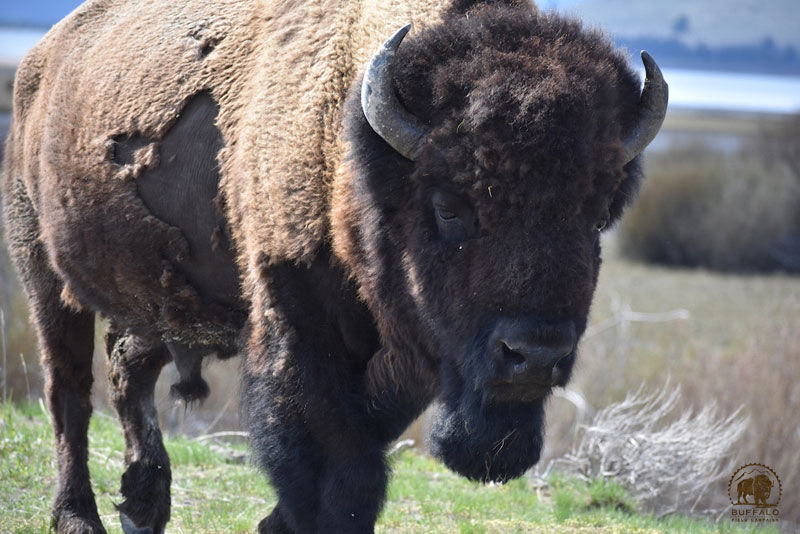
Around the Hebgen Basin, Central herd members continue to bring forth new life. Calving season got off to a bit of a late start, but, now, every day we are seeing more and more calves. Except for a few, short hazing operations and the challenges of the highway, the buffalo are at peace here. Moms can give birth without disturbance, and the calves are able to run, play, and grow strong without the threat of being hazed. While the Central Herd’s numbers are drastically down — our highest count here has been fewer than 250 in this Basin, and less than 100 counted on recons into Yellowstone’s interior — every single calf who is born is a symbol of resistance, an effort to make a comeback from Yellowstone’s senseless slaughter. Each calf is a celebration for the buffalos’ future. And, we want you to celebrate with us. So, instead of a lot of words, here is a little photo journey into wild buffalo calving season!

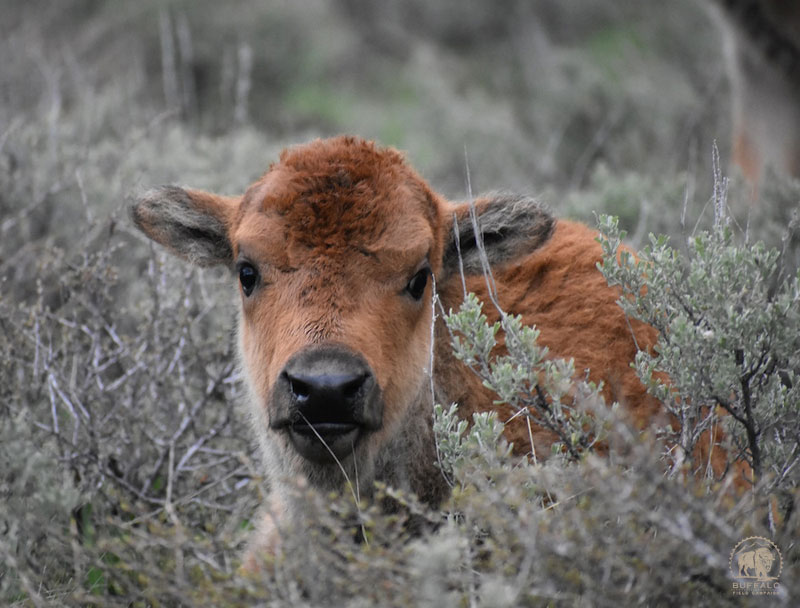

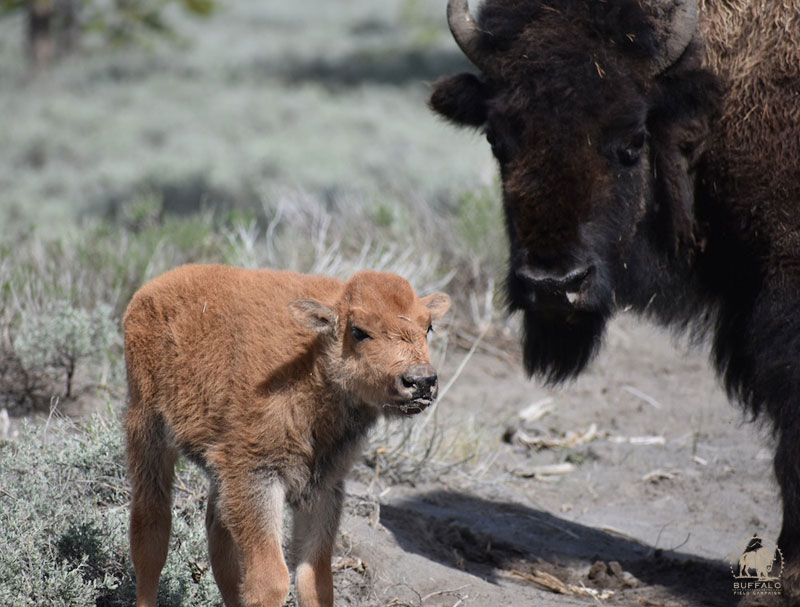



by Deep Green Resistance News Service | Apr 22, 2018 | Movement Building & Support
by Wolfs Wands at GoFundMe
March 16th, Mark Wolf and Coyote participated in a non-violent direct action to prevent trucks and trailers from accessing Yellowstone National Park’s Capture Facility. This winter alone Yellowstone has captured and killed more than 1,000 bison. 3,600 bison remain in the wild. After blocking road access for more than 5 hours, Yellowstone officials created a makeshift road so the trucks and trailers could pass by to pick up the bison. Eventually Yellowstone Police removed Wolf & Coyote and they were arrested. Spending five days in jail they met their fates in federal court. Sentenced to two misdemeanors and $1,936 in restituion Yellowstone as well as court fees Wolf and Coyote are asking for donations from other activists and animal lovers that are opposed to the slaughter and displacement of wildlife. These men made a sacrifice of their freedom in order to protect wildlife. Please contribute to their cause today!
For more info on the American Bison please visit Buffalo Field Campaign
Visit the following links for articles related to this action:
Men Block Road to Yellowstone Buffalo Trap
Yellowstone Bison Slaughter Protester Pleads Guilty
2 more protesting bison slaughter arrested for blocking access road in Yellowstone National Park

by DGR News Service | Mar 16, 2018 | Indigenous Autonomy, Obstruction & Occupation
March 16th 2018
For Immediate Release
Media Contact: Talon Brings Buffalo
406-404-9131
Stephens Creek Trap, Yellowstone National Park
March 16th 2018
Hours before dawn on Friday March 16th, two members of the Wild Buffalo Defense collective arrived at the gate of Yellowstone National Park’s Stephens Creek Buffalo capture facility. They blocked the gate with three 55 gallon drums filled with concrete, locking their arms inside the barrels. The three 1000 pound drums blocked access to the facility, preventing livestock trucks from taking the wild buffalo to slaughter. This action came in the wake of a similar event last week at the Stephens Creek Trap, where two buffalo protectors locked themselves to the hydraulic squeeze shoot using a metal pipe.
Wolf, the first individual locking down, described why he was taking the action: “My father is from Michaocan, Mexico, so I have both native and colonizer blood. Since I wasn’t raised in a native setting, this is my way to give back to the native community. I’m from Illinois — it’s called the Prairie State, and there’s less than one one-hundredth of the prairie left. It’s all strip malls and corn fields…I don’t like seeing just concrete and steel. Seeing how peaceful the buffalo are and how strong they are, they go through enough hardship in their lives in the forest and the plains and then with what Yellowstone National Park is doing to them they still carry on. They inspire me to keep going.”

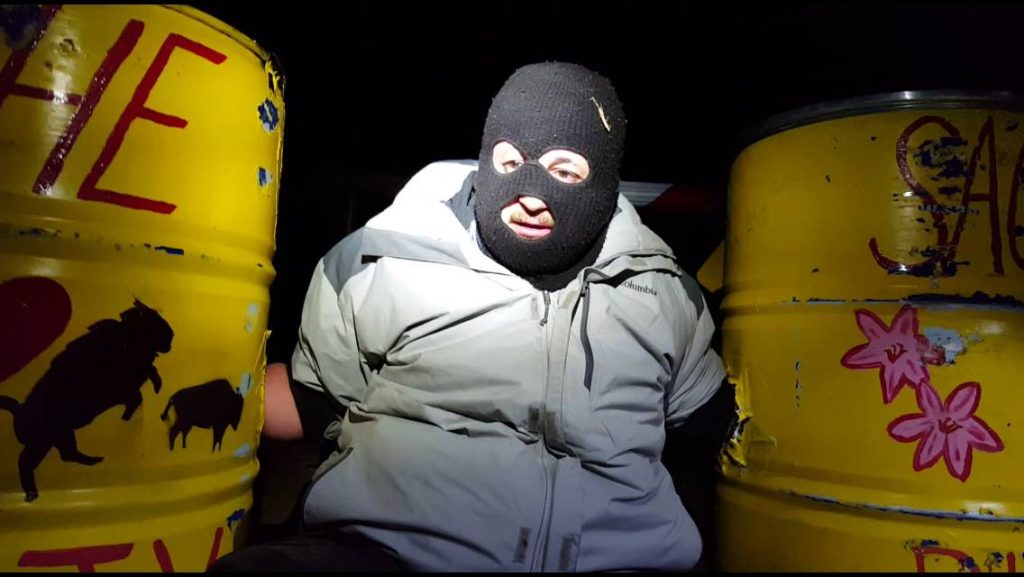
Coyote, the other individual blocking the gate, said: “I’m doing this to get a better understanding of what is really going on and to protect the buffalo and the lands that they roam. I feel like I have been lost inside…but now that I’m here I feel more combined with myself, with others, and with knowledge and understanding. Whenever I’m with the buffalo I feel like my heart runs with them. When I’m with them they already know the questions, they already know the answers, and I don’t have to respond because they already know. I think it’s a good thing for people to learn. There’s not a day in this world where you’re not able to learn something. What we’re doing is something we love to do and we only live once so we should do what we love to do and if anybody wants to come out and join and learn this experience then they should.”
The barrels were painted with two phrases, “Protect the Sacred” and “Honor the Treaties.” The words highlight the fact that Buffalo are sacred creatures to the Plains Indians. Blackfeet and Lakota prophecies say that when the wild buffalo return, the people and the earth will be healed. Yellowstone National Park currently captures and slaughters about 25% of the herd every year. If this mismanagement of the population continues, these prophecies will… [press release ends].

by DGR News Service | Mar 6, 2018 | Biodiversity & Habitat Destruction, Obstruction & Occupation
by Wild Buffalo Defense
Media Contact: Talon BringsBuffalo, 646-352-2126
An hour before sunlight on march 5th two members of the Wild Buffalo Defense collective named Cody and Crow descended from the hills onto Yellowstone National Park’s Stevens Creek buffalo trap and using a steel pipe, locked themselves to the bars of the “Silencer”, a hydraulic squeeze shoot that holds buffalo for testing, shipping and slaughter. In freezing temperatures the individuals blocked the buffalo processing facility and prevented the park from shipping wild buffalo to slaughter.
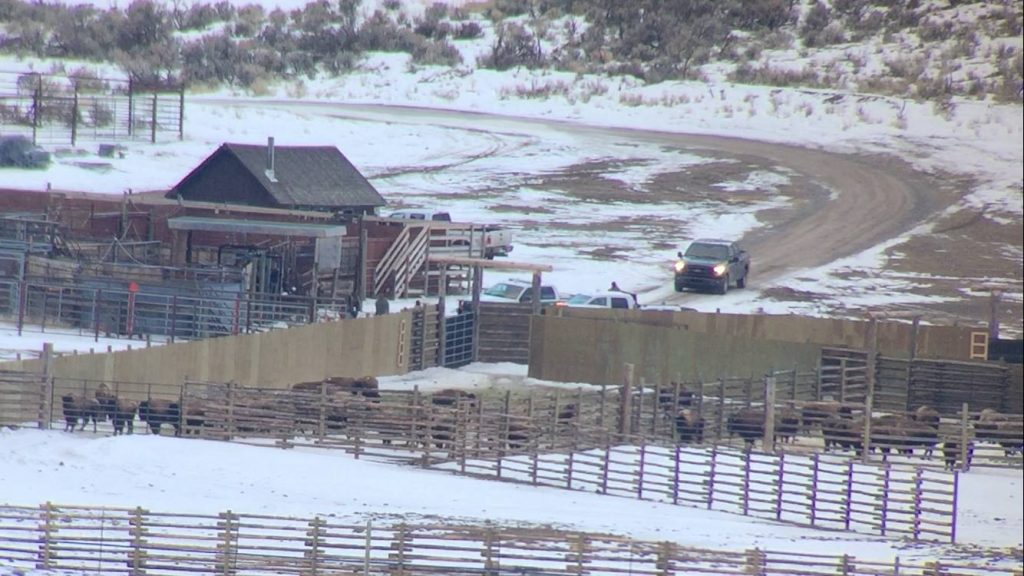 When asked why he was taking this action Cody stated, “I am standing with the plains Indians as a member of the Ojibwe tribe in Minnesota, I have a Blackfeet friend who helped me protect my territory from the line 3 pipeline and now I am here for him and the buffalo. I have a love for the people. That’s what my mom passed down to me. And I have love for the environment and animals and I feel like I have an obligation to protect them. If I have to put my body on the line to do so I will.”
When asked why he was taking this action Cody stated, “I am standing with the plains Indians as a member of the Ojibwe tribe in Minnesota, I have a Blackfeet friend who helped me protect my territory from the line 3 pipeline and now I am here for him and the buffalo. I have a love for the people. That’s what my mom passed down to me. And I have love for the environment and animals and I feel like I have an obligation to protect them. If I have to put my body on the line to do so I will.”
The two Yellowstone buffalo herds are the last free ranging, genetically pure, plains buffalo in the United States. These buffalo are decedents of the 23 that survived the buffalo extermination campaign that the US government implemented in the 1800s to starve the plains Indians into submission.
Today the Stevens Creek Buffalo Trap costs the Yellowstone Parks Service 3 million dollars per year to maintain and despite years of public opposition continues to operate their capture-for-slaughter facility within the park boundary. Activists and tribes allege that the Montana cattle lobby controls how the Parks Service manages of the wild buffalo. Crow, the other individual who locked himself to the facility stated “They say they need to kill the animals to stop the spread of Brucellosis, but the wild elk have Brucellosis and they are allowed to roam free because the cattle industry is not worried about elk competing for grass and the state receives income from the elk hunting permits.” Every year the facility captures and sends roughly 1000 animals of the 4000 wild buffalo population to slaughter.
While the two individuals locked themselves to the shoot, some activists gathered at the gate of the facility with banners reading “Wild buffalo slaughter = cultural genocide.” Their signs spoke to the connection between the culture of the plains tribes and the wild buffalo, suggesting that by exterminating the last wild buffalo, Yellowstone is effectively attempting to do the same to the culture of the plains tribes. The non-violent direct action came in the wake of a decision by the Montana department of livestock and the animal plant and health inspection service to deny the Fort Peck Indian reservation the right to receive wild buffalo from the park.
To Support Wild Buffalo Defense please contribute to our campaign and legal fund!
Campaign Fund: https://www.youcaring.com/wildbuffalodefense-1119076
Legal Fund: https://www.youcaring.com/wildbuffalodefense-1119210
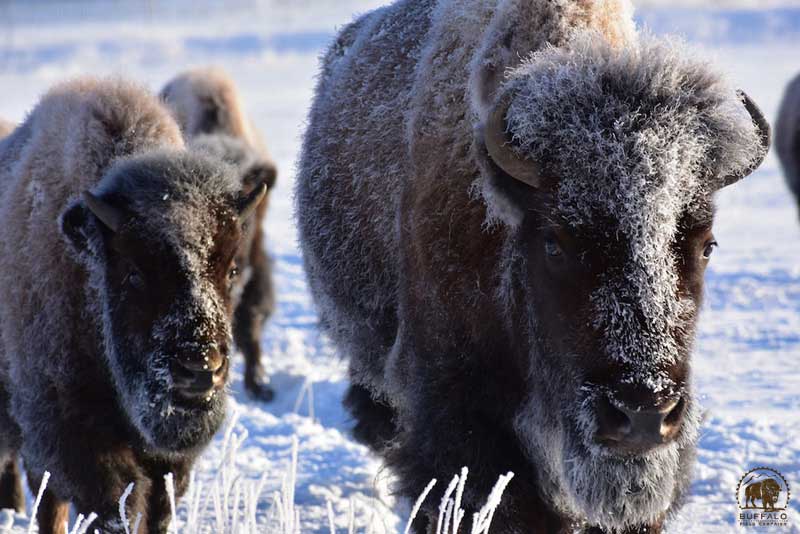
by Deep Green Resistance News Service | Mar 1, 2018 | Biodiversity & Habitat Destruction
Featured image: A single mom with seven calves who she is caring for. More than likely, only one of these calves are hers, and the rest of these babies are buffalo she adopted after their mothers were killed by hunters. BFC photo by Stephany Seay.
by Stephanie Seay / Buffalo Field Campaign
It’s just below zero as we trek through freshly fallen snow on an unusually windless early morning, in the high hills above the Gardiner Basin. Taking advantage of the calm air that won’t rock our scopes and cameras, our patrol is on the way to a lookout spot high above Yellowstone’s Stephens Creek buffalo trap. The trap is miles away. The spot we’re at is one of the few places that we can see even a far-away glimpse into the industrial size monstrosity that has entrapped more than 450 of the gentle giants in the past couple of weeks. Yellowstone initiates a massive seven-mile public closure around their trap, obviously wanting to hide the horrible things they are doing to this sacred species, our national mammal. On our way to the lookout, our footsteps squeaking through the freezing cold snow, one of our crew shouts out, “wolves!” We all stop dead in our tracks. To the south of us, we can hear them, the beautiful, haunting serenade of a wolf pack, singing blessing songs to the morning, or, more like mourning songs to the travesty unfolding before us. The wolves know. We get to the lookout spot and it’s as bad as we thought: hundreds of buffalo in the trap, huddled together, eating hay rations, trapped on death row. Four park wranglers on horseback, and a white SUV are coming into the northernmost paddock of the trap which holds approximately 60 of the country’s last wild buffalo. This paddock is the veritable end of the line before the buffalo go in even deeper, to places they will never return from.
“Genocide,” our Blackfeet brother says. We nod in agreement. The U.S. Government continues the systematic destruction of the sacred buffalo, and for the same reasons, too. Only, these days, instead of Buffalo Bill and Wild Bill Cody, they call it “management” and the killers are the so-called guys in green: Yellowstone National Park. Donning buffalo on their uniform badges, they are the very ones who are obligated to protect the buffalo — the buffalo who are the main reason this park even exists, that people even come here. These “caretakers” are facilitating all of the trapping and most of the killing. As we watch through our scopes and binoculars, eyes teary from the blistering cold, or the pain in our hearts, the wranglers go in for the attack. It’s just another day in the park. Frantic, the sixty buffalo run away from the wranglers, but the only path open to them is the dark corridor that leads into the labyrinth of the trap, towards the bull pen and the squeeze chute, towards the end of freedom and family, into the tiny holding pens where they will spend their last hours in feces and fear, before being loaded onto livestock trailers headed for the slaughter house. The mournful howling continues. The wolves know. We join in.
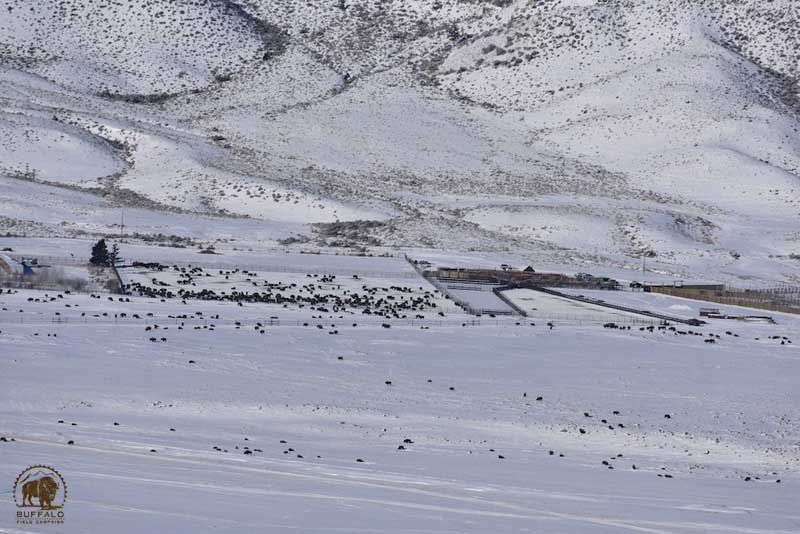
A bird’s-eye view of Yellowstone’s Stephens Creek buffalo trap. The massive closure is an attempt to keep the public from seeing what Yellowstone is doing. BFC photo by Stephany Seay.
Anticipating shipments to slaughter, the next morning we rise even earlier to get our sites on the trap before the trailers arrive. We are well ahead of schedule. Our presence, our vigilance is the only way for anyone to know what is taking place here, for anyone to know what is really happening to the buffalo. Once posted up, we send one patrol high into the hills for an even better birds-eye view. Even so, both lookouts rely on the powerful magnification of spotting scopes to see anything, and tiny-dot-anythings at that. With the naked eye, the trap and it’s happenings are hardly visible at all. The trap is so strategically located that Yellowstone’s shame and desire for secrecy are apparent. Just before dawn, multiple vehicles start arriving to the trap. The unmarked rigs of the wranglers, a few park service law enforcement officers, Yellowstone’s bison biologist, Rick Wallen, and others, get ready for another day of wild buffalo abuse. Then the stock trailers show up, flanked by law enforcement escorts. It takes less than an hour for them turn wild buffalo from sacred, free-born beings into “pounds on the hoof” headed for the slaughter house.
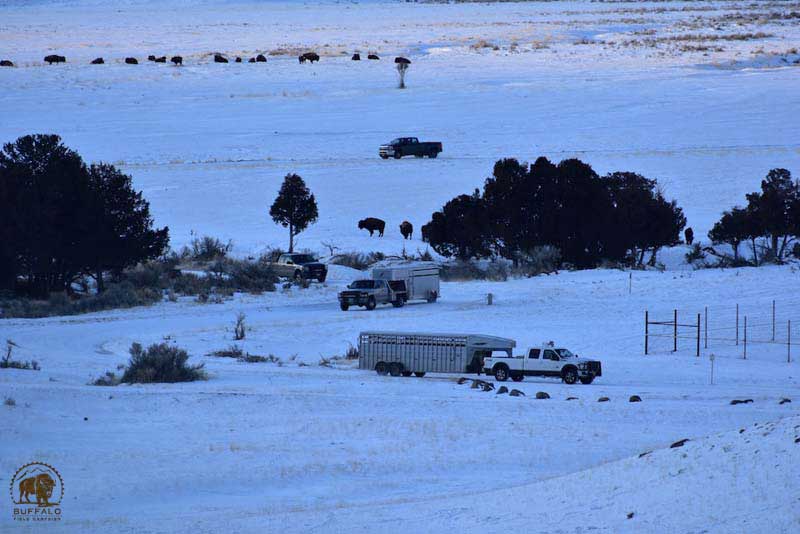
2018 03 01 03 003 Update3 Buffalo Field Campaign Stephany Seay 2018 800 Two stock trailers drive through Yellowstone, and groups of buffalo, taking buffalo who were captured at Yellowstone’s facility to slaughter on Wednesday morning. BFC photo by Stephany Seay.
The dominant culture — not even those who might care — can’t bear to look into the face of the reality of its actions. It views the human supreme; born out of a cold arrogance lusting for control, enabling the conversion of the living into the dead for profit. Forgetfulness, mindlessness – “with guns and laws and truth that lies” – help grease the gears of the machine; numbness is the key to conducting wildlife “management.” It is said that once you see, you cannot unsee. A self-inflicted blindness enables it —to see would break their hearts and force their souls wide open. So, with brutal efficiency, the government workers keep their blinders on, do their jobs, and hold fast to the agreed upon Interagency Bison Management Plan.
Approximately 450 wild buffalo have been captured in Yellowstone’s trap, and nearly 250 have been killed by hunters just across Yellowstone’s boundary. By Yellowstone and Montana’s own standards, the middle-end of their 600-900 kill quota — in place to appease Montana’s cattle interests — has already been met. After the last few weeks of extremely unsavory ‘hunting’ along Yellowstone’s north boundary, very few hunters have come to kill buffalo this week. Many have left here utterly disgusted, vowing never to participate in such a slaughter again.

With their enormous, shaggy heads, buffalo face into a storm. We have much to learn from our relatives, the buffalo. BFC photo by Stephany Seay.
Before and after bearing witness to this insanity, we are reminded of the real reason we are here. Other buffalo, who were not in the trap, gave us the gift of remembering and connection, the honor of being in their presence and living in the moment. They help us remember who we are fighting for — and with — and why. The buffalo help us connect with their humbling ancient wisdom; a truth so incredibly sacred because of its gentle simplicity and rightness.
The blizzard came in quick and heavy, and the buffalo moved right along with it as they always do. With their heads into the storm, grazing and walking, sparing and goofing around, they look up at us for moments with the eyes of god, the faces of ghosts, awakening memories of ages past and future potentials. Still here. Still present. Still doing what they have always done since buffalo time began. Where they walk, ravens feast on the gut piles of their recently killed relatives, strewn across the landscape at Beattie Gulch, a beautiful place that has become synonymous with death. And, yet, the buffalo still come, still offer life, staying among the living. Obstacles be damned. These ancient beings have survived Ice Ages; now the question is: can they survive the U.S. government? In the joy of sharing time and place with the buffalo, in our pain and anger fueled by management plans, being in the company of friends both human and buffalo recognizing each other, committing to each other again; in our solidarity among our comrades we understand that all of these things come from love. Profound love. The buffalo and their wildness, their teachings of sorrow and joy, their obligation to the earth, and ours to them. These realities keep awake our spirits, reaffirm and strengthen our vow: yes, you will survive, and we will give ourselves to make sure of it; fighting for you, along side you.


















